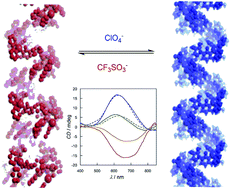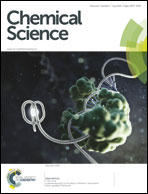Homochiral self-assembly of biocoordination polymers: anion-triggered helicity and absolute configuration inversion†
Abstract
The different natures of the weakly coordinating anions – triflate or perchlorate – in the Cu2+-mediated self-assembly of cytidine monophosphate nucleotide play a fundamental role in the homochiral resolution process, yielding one-dimensional copper(II) coordination polymers of opposite helicity that can be easily inverted, in a reversible way, by changing the nature of the anion as revealed by circular dichroism experiments both in solution and in the solid state.



 Please wait while we load your content...
Please wait while we load your content...